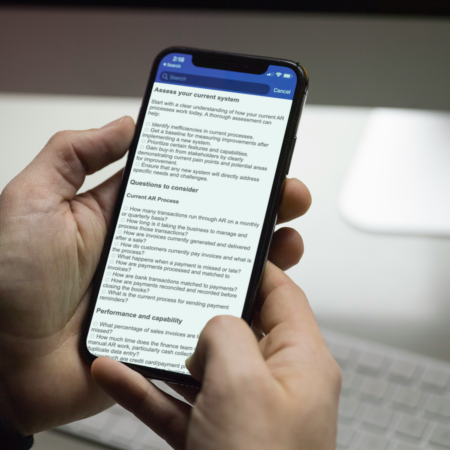
We’ve come a long way since “accounting software” meant a series of spreadsheets. Instead of a separate general ledger, project accounting ledger, billing software, and inventory tracking program, integrated accounting systems handle it all. They’re the key to integrated accounting.

With the right integrated accounting software, you can spend less time on accounting tasks and reduce potentially costly data entry errors. Here’s everything you need to know about how accounting system integration works and how to choose the right tool for your business.
Newsletter sign up
"*" indicates required fields
What is Integrated Accounting?
An integrated financial accounting system connects all your business financial data into one software platform. A good system will link your general ledger, payment systems, tax calculations, inventory management, and more. The result? Less time spent entering numbers and fewer bookkeeping errors.
The Elements of Integrated Accounting Systems
Whether your business is large or small, built on remote teams or brick-and-mortar locations, you need an integrated financial accounting system that fits your company’s unique requirements.
An effective system should handle common accounting integration features like automating the general ledger and automatic financial reporting. It should also shift everything to the cloud so it’s accessible from anywhere, on any device. These functions alone can make your life easier, but many businesses want more.
Maybe you want a system that adjusts inventory levels when you report a sale. Or maybe you need software that handles your billing for you. The best systems allow for easy customization so they can adapt to your needs. Here are some of the components in the top integrated accounting software solutions.
1. Automated General Ledger
When you enter information into an integrated accounting system, it’s immediately stored in a central database, where all the system’s elements can access it. It doesn’t matter which digital door the data comes in through—you only have to enter it one time. The software then posts it into all the necessary ledgers and accounts, thanks to a robust automated general ledger.
2. Easy Billing and Invoicing
With integrated accounting software, automated billing and invoicing features connect your sales data directly to your invoicing. When you close a sale, the system automatically sends an invoice to the customer. You can also quickly set up recurring billing plans for individual clients, and get fast access to an overview of the billing activity for any given contract.
Some accounting software integrations also offer built-in cross-functionality with payment-processing programs such as Stripe. This supports fast, easy payments, adding convenience and security for your customers.
3. Accounts Payable Automation
Payment automation can manage credit card transactions, accounts payable, and purchasing, all on the same integrated platform. With a traditional accounting system, credit card orders create a data-entry bottleneck while you hand-jam transactions into your accounting system.
4. Inventory and Sales Management
Inventory management is tied closely to accounting processes. A robust integrated accounting software tool can manage your inventory right from the app, tracking inventory levels, replenishing stock, and even customizing your purchasing process all in one place.
This makes it easy to monitor and manage inventory levels in multiple warehouses and locations, reducing the need for manual counts. The right software solution also makes it easier to manage your sales orders. You can create them, approve them, and track the process to see that it’s flowing smoothly.
This handy feature lets you allocate inventory to specific customer orders, create purchase orders from sales orders, and record packing and shipping details with no additional data entry.
If you’re using Salesforce, explore this helpful resource about Salesforce Order Management Best Practices.
5. Project Accounting
Small start-ups can manage their accounting with a simple general ledger. But if you’re juggling dozens of contracts, you need separate ledgers to track expenses, overhead, and budgets on each one. Later you’ll have to add that information back into the general ledger.
Without an integrated accounting system, project accounting often becomes a nightmare. It’s a lot of extra work to segregate specific expenses and revenue to different projects. If your system requires you to manually re-enter the data in your general ledger as well, that increases the chance that a team member will mistype a number and throw off the accounting.
With the right accounting integration, your general ledger and your project ledgers become part of one smooth system, connected to the core database. You don’t have to do anything extra to include a project’s financial figures in both ledgers. That way you can easily track finances throughout the project’s life cycle.
6. Sales Tax Management
Sales taxes are a key funding source for counties, cities, and other local government bodies. Keeping track of all the rates you have to pay can become challenging. A robust integrated accounting software tool will calculate rates and dollar amounts effortlessly, surfacing how much you owe—both in total and by creditor or vendor.
The most sophisticated software can also calculate use taxes for you. And if you’re doing business overseas in a country that collects value added tax (VAT), an integrated accounting system can calculate those payments too.
7. Financial Dashboards Out of the Box
Business-driving insights come from a high-level view of your financials. An effective system can represent data easily and graphically with customizable financial dashboards. This feature makes financial information available and accessible to your team in real time.
Effective dashboards are easy to customize so they generate the information you need most, such as sales metrics, statistics, or performance history. Clear visuals can help you understand the data even in the absence of a data scientist. You can also use these dashboards to make clear presentations to upper management or other key stakeholders.
Here’s a guide to the 20 Best Financial Dashboards for Businesses to keep in mind.
8. Security You Can Trust
There were 1,862 data breaches in 2021. That’s a gain of 68% in just one year. These breaches affected almost 300 million people at a cost of nearly $8 billion. The best integrated accounting system is packed with excellent IT security features, including:
- Accounting security
- Auditing
- Tracking compliance with legal and company requirements
- Encryption
- Event monitoring to detect unauthorized access attempts
- Secure email
- Two-factor authentication
- Permission sets
Learn more about preventing cyber attacks in our Accounting Cybersecurity guide.
9. Point and Click Customization
When you run a business, you soon develop your own way of doing things. What you need from integrated accounting software may be completely different from what other companies need—even those in your own industry. A good accounting system should be easy to configure and customize.
You can tailor the best software to your needs with a simple point and click, without entering complex instructions. If you do business overseas, a platform that operates seamlessly in foreign languages is an asset.
Benefits of Integrated Accounting Software
Many small businesses get along fine with basic accounting software or legacy systems that don’t let management integrate their disparate functions. But just because an aging system works doesn’t make it ideal. Here are a few of the advantages of an integrated financial accounting system.
- Automated sales data entry and tracking. With an integrated accounting system, you can easily see and track all your sales data in one place. There’s no additional data entry step to add the info to your digital ledger after you’ve made a sale.
- Real-time transaction tracking. Since you don’t need to manually move information from your ordering system to your accounting system, you can see the state and health of your business at a glance at any given time.
- Accurate budget and cost comparisons. Integrated accounting software connects directly to your order management system. That feature lets you quickly calculate job costs and sales commissions in real time.
- Fewer errors. With accounting system integration, there’s no data entry step after you make each sale. That means there’s no way to introduce errors during data entry.
- Increased productivity. There’s no need to re-key sales data after you make each sale. That frees up your team to perform higher-value tasks.
- Faster decision making. With a real-time, graphical view of all your financials that’s endlessly customizable from every angle, you can spot trends and react quickly to take advantage of emerging opportunities.
How to Set Up an Integrated Accounting System
There are a few vital steps to take when setting up your own integrated accounting system. Consider how much power and functionality you’ll need, choose an integration timeline, install, troubleshoot, train, and then migrate your data.
- Decide on the right system. You may be thinking of purchasing a good accounting system because it’s ranked as the best, most powerful, or most sophisticated. But powerful systems are often complex, and many CFOs say they’re too complicated to use, master, and customize. Therefore, carefully consider the level of complexity you need.
- Choose an integration timeline. Decide on the pace you’ll follow as you implement your integrated accounting software. It’s important to consider whether you’ll launch immediately after installing or phase it in gradually.
- Install and troubleshoot. Before you make the switch, fully test your new integrated accounting system to make sure your network, hardware, and other software tools will play well with it.
- Train your team. Give your team the time and resources they’ll need to get up to speed with the new system.
- Map your process to the system. Before you can use your new accounting system, you’ll need to match its features and functions to your real world processes. This includes your business areas, workflows, transactions, IT structures, and security.
- Migrate your data. Move the necessary data from your legacy system to your new accounting system. Allow a troubleshooting period to ensure the new setup works smoothly with your business.
Accounting Seed for Accounting Integration
Accounting Seed is a fully integrated accounting software tool designed to pull all your accounting processes together on day one. The platform is built natively on Salesforce, so it can merge your Salesforce data directly with your accounting workflows.
Integrating CRM and accounting makes it easier to combine financial and customer data, helping you sell faster and smarter. You can use Accounting Seed to create custom and pre-built reports, and visually track your company’s performance in real time.
Accounting Seed’s ready-on-day-one integrated accounting system helps keep your communication with customers consistent, whether you’re using email, social media, online chats, or phone calls to stay in touch. It also lets you spot business-driving insights fast, without extra work or prep.
Leverage Accounting Seed’s Integrated Accounting
Accounting Seed delivers powerful accounting integration that makes it easier to run your business more strategically. If you want to see how Accounting Seed can completely transform your systems, book a custom demo of Accounting Seed today.
Read on:
- Top 7 Issues Accountants Face Today
- Small Business Accounting Tips
- DCAA Compliant Accounting Software: What to Look For
- What are the International Accounting Standards (IAS)?
- Top 8 Reasons Why IT Implementations Fail
- What is Cash Disbursement in Accounting?
- Accrued Expenses: What are They and How to Report Them?
- Intro to Accounts Payable and Purchase Order Accounting
- Vendor Payment Processes: Everything to Know
- What is Project Accounting? How to Do It Best
See Accounting Seed in action
Get a close-up view of how accounting on Salesforce can eliminate the need for costly integrations—and silos of mismatched information—by sharing the same database as your CRM.


